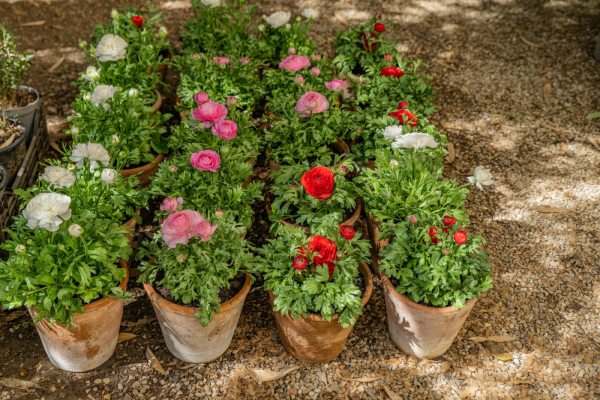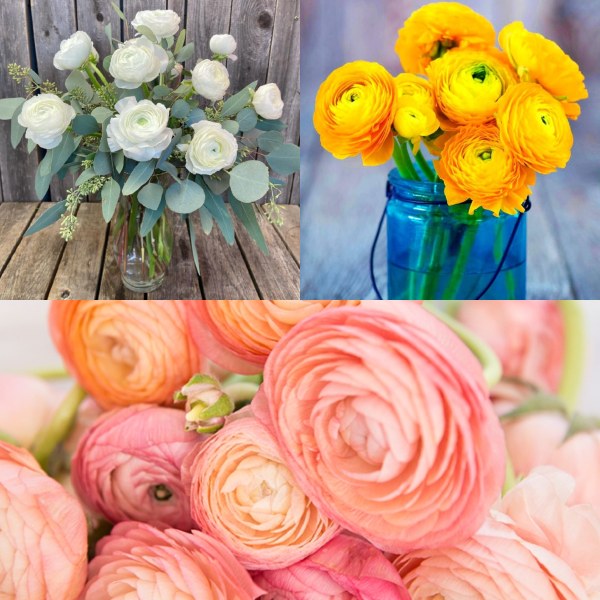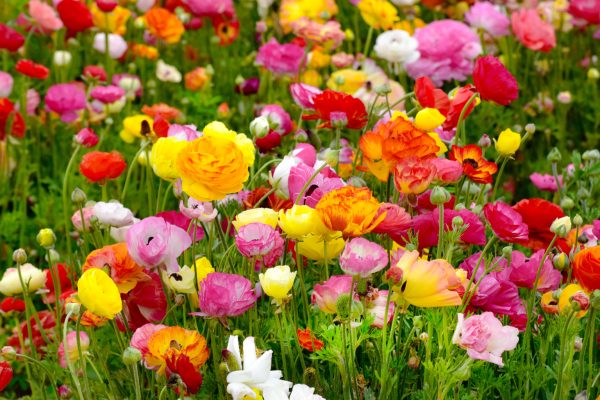Ranunculus, often called Buttercups, are renowned for their vibrant colors and delicate, layered petals. These charming flowers belong to the Ranunculus genus, which contains hundreds of species, including wild and cultivated varieties.
Ranunculus typically blossoms into grace gardens, landscapes, and floral arrangements during spring, adding a burst of color to the surroundings. While some varieties with tiny white and yellow flowers can even be found in aquatic locations.
Today in this article, we will explore the various types of Ranunculus, how to grow, and take care of them.
What is special about Ranunculus?
Ranunculus are beautiful spring blooms with small, bright, soft petals that look like delicate paper flowers. These rose-like flowers dazzle in an array of colors, from lush yellows to tender pinks and fiery oranges, attracting both gardeners and florists.
The distinctive feature of Ranunculus is its layered petals, which resemble small peonies that add a fascinating charm to bouquets and garden settings. Despite their delicate appearance, they flourish in a variety of climates and soil types, making them popular choices for weddings, floral displays, and garden landscapes alike.

However, Ranunculus can be poisonous to people, dogs, cats, and horses if ingested. Inside their delicate petals, there are harmful substances, like protoanemonin.
Growing Ranunculus: Essential Care and Growth Tips
Growing healthy Ranunculus requires proper care and cultivation. Fortunately, Ranunculus are relatively easy to grow and can enhance the beauty of any garden. Here, we explore the primary care steps to grow ranunculus flowers while ensuring healthy and abundant blooms.
Light
Ranunculus grows best in places with lots of sunlight or a bit of shade. They bloom the most when they get full sun. Pick a spot that gets at least six hours of sun every day. If the plant didn’t get enough sunlight, they might not bloom as much and their stems might not be as strong. So, it is important to give them plenty of light to help them grow well.
Soil and Water
To plant ranunculus bulbs, use soil that drains well and is full of nutrients. Some types of ranunculus, like Ranunculus repens, prefer soil that is wetter and denser, such as soil near ponds, as they like damp areas. Water the plants once a week in the morning after planting. When the flowers die and the leaves turn yellow, water them less, especially if you want to dig up the bulbs and save them for next year.
Temperature and Humidity
Ranunculus flowers grow best in mild weather during spring, summer, and early autumn. These flowers like cooler spring temperatures, around the 60s to low 70s. When summer brings heat and humidity, they stop blooming, and the leaves may fade. Similarly, Ranunculus grows well in normal humidity. High humidity can lead to fungal problems, so it’s best to avoid it.

Fertilizer
Once your ranunculus begins to grow, provide them with regular feedings using either a balanced fertilizer or bone meal, following the instructions on the product. Likewise, if your ranunculus grows in meadows or near ponds and streams, they don’t need fertilizer. Because ranunculus flowers have a short growing season, they typically don’t require additional fertilizer.
Pruning
While pruning isn’t necessary for ranunculus, it is important to inspect the plant regularly and remove any damaged or diseased leaves. Before trimming the plant, clean your scissors. Taking off old flowers, called deadheading, promotes the growth of new blooms, ensuring a continuous display of colorful flowers.
Potting and Repotting
If you are growing ranunculus as a one-time plant, you don’t need to move them to a new pot. But if you are growing them in pots for many years, they might get too big for their pot. If that happens, put them in a bigger pot with fresh soil, or split them up and put them in different pots.
Pests and Problems
Ranunculus flowers might be harmed by powdery mildew, gray mold, or aphids. Powdery mildew looks like light gray or white powder on the leaves, stems, or flowers. To stop it, water the plants well and put them where they can get some sun. Gray mold grows when it gets very humid. While Aphids are small bugs that can bother garden plants. You can use special soap or oil to get rid of them.
Exploring Ranunculus Varieties and Colors
Ranunculus come in a wide array of species, from wildflowers to cultivated varieties known for their striking blooms. Every variety has its beauty, adding a delightful burst of color and charm to gardens, bouquets, and landscapes. Similarly, some varieties have multiple colors within their petals including yellow, orange, white, deep red, purple, and coral. Some of them are mentioned below.
Butterfly Ranunculus
Butterfly Ranunculus flowers are single-formed, with delicate, shiny petals and multiple branches on each stem. Each stem can bear around 7-12 flowers, reaching up to 36 inches in length. Their petals have a stunning pearlescent quality, often displaying an ombre effect, transitioning from darker to lighter shades within each petal.
Unlike other Ranunculus varieties, Butterfly Ranunculus plants tend to grow fuller and wider, producing more flowers per stem. Unlike other Ranunculus, they don’t have many leaves and their stems are solid, which helps them stay healthy. Similarly, they thrive in cool weather and can handle a little frost.
White Ranunculus
The White Ranunculus blooms are like round, heavily-petaled balls of pure white, bringing enchantment to your garden. Their dark centers are surrounded by silky white petals, rising elegantly from slender green stems and leaves.
These plants grow to about 10 to 12 inches tall, producing stunning flowers reminiscent of camellias, with ruffled petals and dark centers, complemented by delicate foliage. They are a popular choice for spring weddings, cherished by florists, brides, and gardeners alike for their abundant, cup-shaped flowers.

Peach Ranunculus
Peach Ranunculus are renowned for their slender, gracefully curved stems and soft petals. Ideal for brides seeking a delicate, airy blossom for their wedding, these flowers effortlessly complement any floral arrangement.
While they blend seamlessly with other blooms, they also stand out beautifully on their own. Ranunculus are especially cherished by DIY brides for their frilly petals and naturally curved stems, resembling a smaller peony or a larger rose.
Also, they are perfect for bouquets, boutonnieres, and centerpieces. However, their curved stems may require wiring if a straighter appearance is preferred.
Pink Ranunculus
Pink Ranunculus showcases layers upon layers of delicate pink petals, forming lush rosette blooms that gracefully emerge above its jagged foliage. These charming flowers thrive when planted at the forefront of garden borders or filling containers, offering a lavish display in late spring.
With proper protection from chilly, damp winter conditions, you can cultivate your own abundant supply of these luxurious blossoms. They are ideal for cut flower gardens, rockeries, containers, and sheltered borders, seamlessly transitioning between the colorful bursts of spring bulbs and the arrival of summer perennials.
Frequently Asked Questions
1. When does Ranunculus bloom?
Ranunculus typically bloom in late spring to early summer, depending on the climate and specific variety.
2. Does Ranunculus come back every year?
Ranunculus is typically grown as an annual. However, in certain conditions, some varieties of ranunculus may behave as perennials, returning year after year
3. Do Ranunculus bulbs multiply?
Yes, Ranunculus bulbs can grow more over time. As the plant gets older and makes flowers, it can also make new bulbs or corms underground.
Also read, A Complete Guide to Growing and Nurturing Mexican Hat Flowers (Prairie Coneflower)
